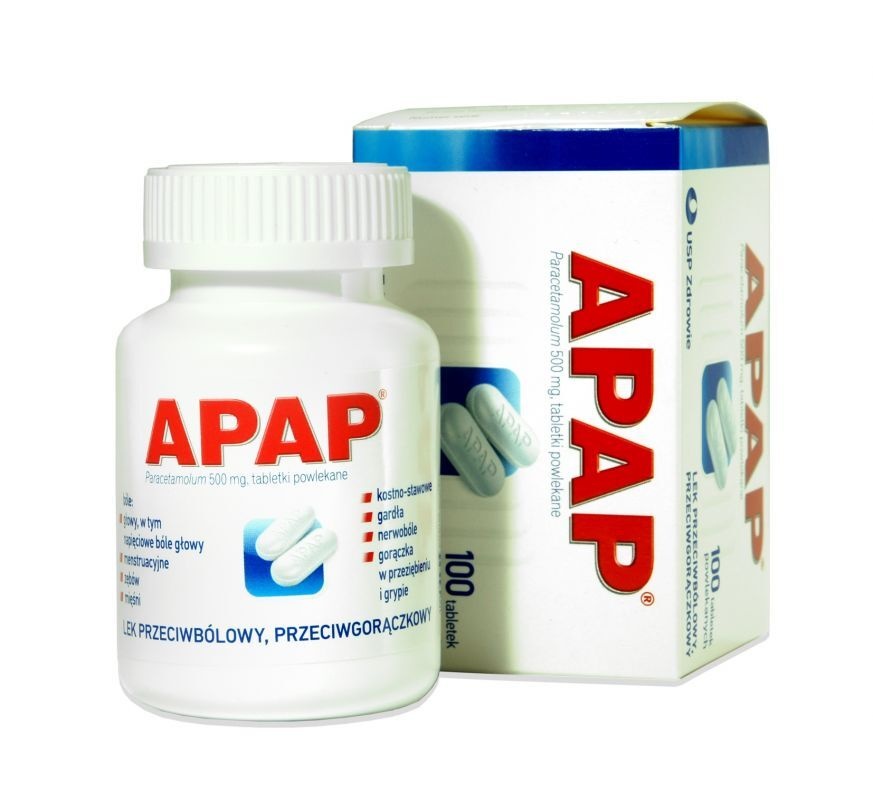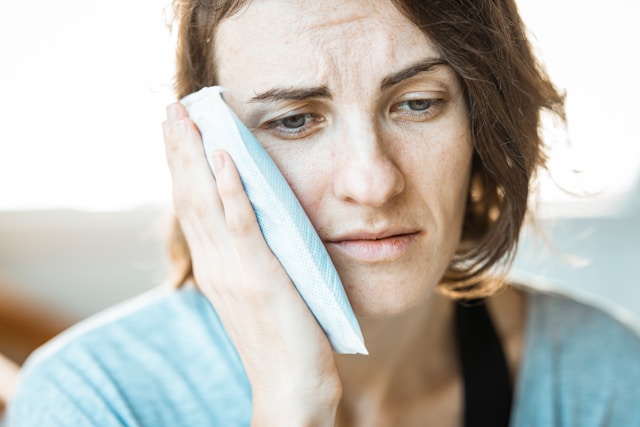

Apap

Ask a doctor about a prescription for Apap

How to use Apap
Package Leaflet: Information for the Patient
APAP
500 mg, Coated Tablets
Paracetamol
Read the package leaflet carefully before taking the medicine, as it contains important information for the patient.
This medicine should always be taken exactly as described in the package leaflet or as directed by a doctor or pharmacist.
- Keep this leaflet, you may need to read it again.
- If you need advice or further information, consult a pharmacist.
- If you experience any side effects, including any not listed in this leaflet, tell your doctor or pharmacist. See section 4.
- If after 5 days (pain) or 3 days (fever) there is no improvement or you feel worse, consult a doctor.
Table of Contents of the Leaflet
- 1. What is APAP and what is it used for
- 2. Important information before taking APAP
- 3. How to take APAP
- 4. Possible side effects
- 5. How to store APAP
- 6. Contents of the pack and other information
1. What is APAP and what is it used for
APAP contains the active substance paracetamol and is a pain reliever and antipyretic.
The indication for use is pain of various origins: headache (including tension headache),
menstrual, toothache, muscle, bone and joint, throat, neuralgia, and fever, e.g., in colds
and flu.
APAP is indicated for use in adults and adolescents over 12 years of age.
2. Important information before taking APAP
When not to take APAP:
If the patient:
- has previously been diagnosed with hypersensitivity to paracetamol or any other component of this medicine (listed in section 6),
- has severe liver or kidney failure,
- has a congenital deficiency of glucose-6-phosphate dehydrogenase or methemoglobin reductase,
- is a child under 12 years of age.
Warnings and precautions
Due to the risk of overdose, ensure that other medicines taken do not contain paracetamol. If a higher dose than recommended is taken, the patient should immediately consult a doctor, even if no symptoms have occurred, as this may lead to life-threatening liver damage.
Before starting APAP, discuss with a doctor or pharmacist if you have liver or kidney failure, and asthma.
Taking the medicine by people with liver failure, alcohol abuse, and malnutrition creates a risk of liver damage. During treatment with APAP, do not drink alcohol due to the risk of toxic liver damage.
During APAP treatment, immediately inform your doctor if you have severe diseases, including severe kidney dysfunction or sepsis (when bacteria and their toxins circulate in the blood, leading to organ damage) or malnutrition, chronic alcoholism, or if you are also taking flucloxacillin (an antibiotic).
In these situations, patients have been reported to develop a severe disease called metabolic acidosis (a blood and body fluid disorder), when they took paracetamol in regular doses for a longer period or when they took paracetamol with flucloxacillin.
Symptoms of metabolic acidosis may include: severe breathing difficulties, including rapid deep breathing, drowsiness, feeling of nausea (nausea) and vomiting.
Children and adolescents
Do not give to children under 12 years of age (the restriction is due to the form of the medicine).
APAP and other medicines
Tell your doctor or pharmacist about all medicines you are taking, have recently taken, or plan to take.
Do not take APAP with other medicines containing paracetamol, MAO inhibitors (medicines used, among others, in depression), and for up to 2 weeks after stopping them, and with zidovudine (an antiviral medicine used in HIV infection). When taking oral anticoagulants (warfarin, coumarin), rifampicin, and isoniazid (medicines used in tuberculosis treatment), antiepileptic drugs, barbiturates (medicines with a sedative and hypnotic effect), diflunisal (a pain reliever), sulfinpyrazone (a medicine used in gout treatment), or other medicines that induce liver microsomal enzymes, consult a doctor before taking APAP. Caffeine enhances the analgesic effect of paracetamol.
Tell your doctor or pharmacist if you are taking:
- flucloxacillin (an antibiotic) due to the serious risk of blood and body fluid disorders (called metabolic acidosis), which must be urgently treated (see section 2).
Taking APAP with food and drink and alcohol
It is recommended to take the medicine on an empty stomach, as this allows for faster pain relief and antipyretic effects.
During paracetamol treatment, do not drink alcohol due to the increased risk of liver damage. Particular risk of liver damage exists in malnourished people, regular alcohol drinkers, and patients with alcoholic liver disease without cirrhosis.
Pregnancy, breastfeeding, and fertility
If you are pregnant or breastfeeding, think you may be pregnant, or plan to have a child, consult a doctor before taking this medicine.
APAP can be given to pregnant women if necessary. Use the lowest effective dose for the shortest possible duration.
If pain is not relieved or fever does not subside, or if it is necessary to increase the frequency of taking the medicine, consult a doctor.
Driving and using machines
Taking the medicine does not affect psychomotor performance.
The medicine contains less than 1 mmol (23 mg) of sodium per single dose (2 tablets),which means the medicine is considered "sodium-free".
3. How to take APAP
This medicine should always be taken exactly as described in the package leaflet or as directed by a doctor or pharmacist. If in doubt, consult a doctor or pharmacist.
Usually, the recommended dose is:
- adults: 1-2 coated tablets (500-1000 mg of paracetamol), if necessary, 3-4 times a day (maximum 8 coated tablets in 24 hours, i.e., 4 g of paracetamol per day). Maintain an interval of at least 4 hours between doses.
- adolescents over 12 years of age: 1 coated tablet, i.e., 500 mg of paracetamol, if necessary, 3 to 4 times a day. Maintain an interval of at least 4 hours between doses. Without consulting a doctor, do not take the medicine if pain persists for more than 5 days or fever for more than 3 days.
It is recommended to take the medicine on an empty stomach, as this allows for faster pain relief and antipyretic effects.
If you feel that the effect of the medicine is too strong or too weak, consult a doctor.
Use in children:
Do not give to children under 12 years of age (the restriction is due to the form of the medicine).
Overdose of APAP
In case of taking a higher dose than recommended, immediately consult a doctor, even if you feel well, due to the risk of delayed, severe liver damage.
Within a few to several hours after taking the medicine, the following may occur: nausea, vomiting, excessive sweating, drowsiness, and general weakness. These symptoms may resolve the next day, despite the onset of liver damage, which then manifests as abdominal distension, return of nausea, and jaundice.
In every case of taking a single dose of paracetamol of 5 g or more, induce vomiting if it has been less than an hour since ingestion and immediately consult a doctor. It is worth administering 60-100 g of activated charcoal orally, preferably mixed with water to bind the remaining medicine present in the stomach.
Missed dose of APAP
The medicine is taken as needed, when symptoms occur, according to the recommended dosage and frequency of administration.
Stopping APAP treatment
APAP is intended for short-term treatment of pain and fever, so its use can be stopped at any time.
4. Possible side effects
Like all medicines, APAP can cause side effects, although not everybody gets them.
If you experience any of the following symptoms, do not take the medicine and immediately consult a doctor. These are life-threatening conditions. They occur very rarely.
- angioedema (swelling of the face, lips, tongue, throat, difficulty breathing), anaphylactic shock (dizziness, impaired consciousness, rapid heartbeat, blood pressure drop),
- severe skin reactions.
Other side effects that occur rarely (in 1 to 10 out of 10,000 patients taking the medicine):
- hypersensitivity reactions, hives, rash, erythema,
- nausea, vomiting, digestive disorders, very rare (less than 1 in 10,000 patients taking the medicine):
- thrombocytopenia (decreased platelet count),
- agranulocytosis (decreased granulocyte count, up to their complete absence),
- bronchospasm in patients with hypersensitivity to acetylsalicylic acid and other nonsteroidal anti-inflammatory drugs,
- acute liver damage, most often due to overdose,
- petechiae. frequency not known (cannot be estimated from available data):
- a serious condition that can cause acidification of the blood (so-called metabolic acidosis), in patients with severe disease, taking paracetamol (see section 2).
Reporting side effects
If you experience any side effects, including those not listed in this leaflet, tell your doctor or pharmacist. Side effects can be reported directly to the Department of Drug Safety Monitoring of the Office for Registration of Medicinal Products, Medical Devices, and Biocidal Products,
Aleje Jerozolimskie 181C, 02-222 Warsaw, tel.: +48 (22) 492 13 01, fax: +48 (22) 492 13 09,
website: https://smz2.ezdrowie.gov.pl
Side effects can also be reported to the marketing authorization holder.
By reporting side effects, you can help provide more information on the safety of this medicine.
5. How to store APAP
Store the medicine at a temperature below 25°C. Keep out of sight and reach of children. Do not use the medicine after the expiry date stated on the carton and blister pack (month/year). The applied labeling for the blister is: EXP - expiry date, Lot - batch number. The expiry date is the last day of the specified month.
6. Contents of the pack and other information
What APAP contains
The active substance of the medicine is paracetamol (Paracetamolum)
One coated tablet contains 500 mg of paracetamol.
The other excipients are: Carnauba wax, hypromellose, macrogol, povidone, starch, sodium croscarmellose, stearic acid.
What APAP looks like and pack contents
White, oblong tablet with a transparent coating, with the APAP monogram embossed on one side.
Available packs
2 tablets in a sachet; 2 tablets in 1 blister; 4 tablets in 1 blister; 6 tablets in 1 blister; 8 tablets in 1 blister; 10 tablets in 1 blister; 12 tablets in 1 blister; 24 tablets in 2 blisters of 12 each; 50 tablets in a bottle; 60 tablets in a bottle; 100 tablets in a bottle; 200 tablets in a bottle. Blister and bottle in a cardboard box.
Not all pack sizes may be marketed.
Marketing authorization holder and manufacturer
US Pharmacia Sp. z o.o., ul. Ziębicka 40, 50-507 Wrocław
To obtain more detailed information on this medicine, consult:
USP Zdrowie Sp. z o.o., ul. Poleczki 35, 02-822 Warsaw, tel. +48 (22) 543 60 00.
Date of last revision of the leaflet:
- Country of registration
- Active substance
- Prescription requiredNo
- Manufacturer
- ImporterUS Pharmacia Sp. z o.o.
- This information is for reference only and does not constitute medical advice. Always consult a licensed doctor before taking any medication. Oladoctor is not responsible for medical decisions based on this content.
- Alternatives to ApapDosage form: Tablets, 500 mgActive substance: paracetamolManufacturer: Farmaceutyczna Spółdzielnia Pracy "Galena"Prescription not requiredDosage form: Tablets, 300 mgActive substance: paracetamolManufacturer: Farmaceutyczna Spółdzielnia Pracy "Galena"Prescription not requiredDosage form: Tablets, 325 mgActive substance: paracetamolManufacturer: US Pharmacia Sp. z o.o.Prescription not required
Alternatives to Apap in other countries
The best alternatives with the same active ingredient and therapeutic effect.
Alternative to Apap in Spain
Alternative to Apap in Ukraine
Online doctors for Apap
Discuss dosage, side effects, interactions, contraindications, and prescription renewal for Apap – subject to medical assessment and local rules.









